| |
|
|
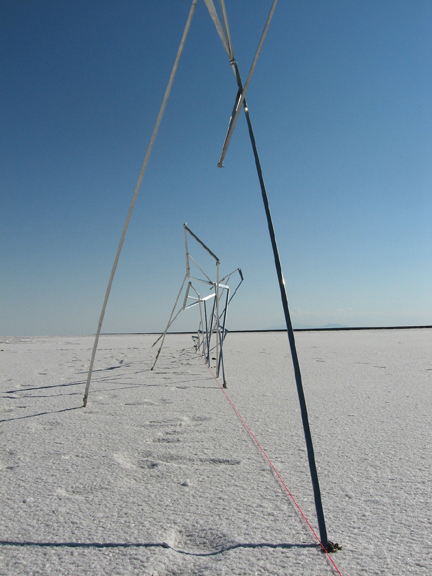 |
|
|
|
| |
|
|
Land Drawings: Bonneville Salt Flats
2006
Aluminum, Twine
6 ft by 4 ft by 250 ft
|
|
|
|
| |
|
|
The Land Drawings were created over two months on public land in Utah, Arizona, New Mexico, and Northern Mexico. A kit of parts was assembled into three dimensional line structures at each site. On the salt flats, the horizon became the defining feature, orienting one's vision, but also, in its constancy, disorienting. Using reflective aluminum, I retraced the paths taken by my fellow passengers when we walked out onto the flats for the first time and mounted them vertically as portals. |
|
|
|
| |
|
|
|
|
|
|
| |
|
|
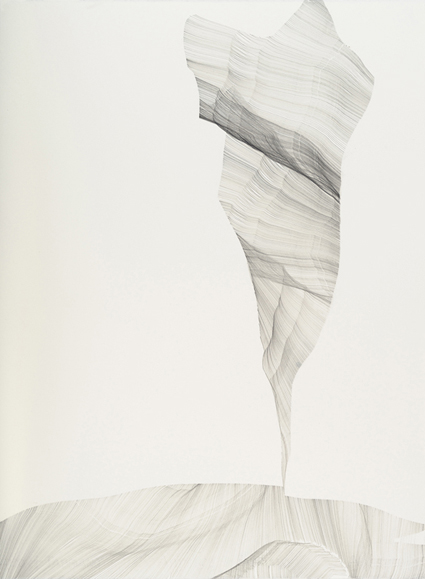 Shatter
Shatter
2010
22 by 30 in.
graphite, charcoal, colored pencil on paper
|
|
|
|
| |
|
|
|
|
|
|
| |
|
|
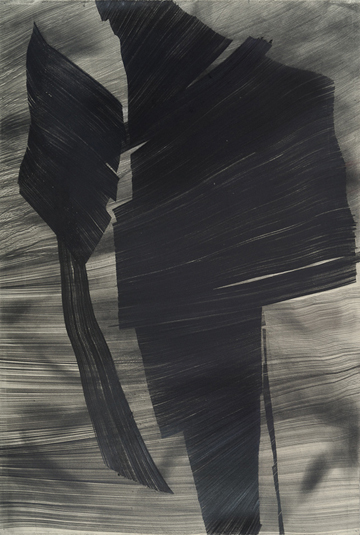 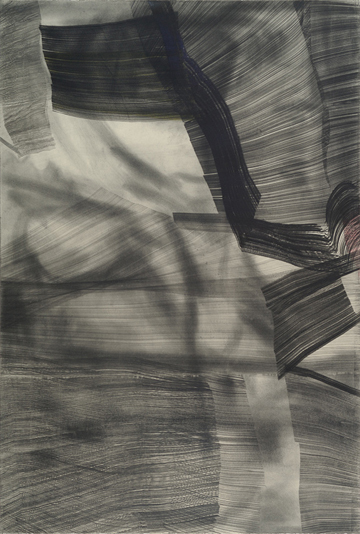 |
|
|
|
| |
|
|
Imbricate
2010
44 by 30 in. (each)
graphite, charcoal, colored pencil on paper
|
|
|
|
| |
|
|
|
|
|
|
| |
|
|
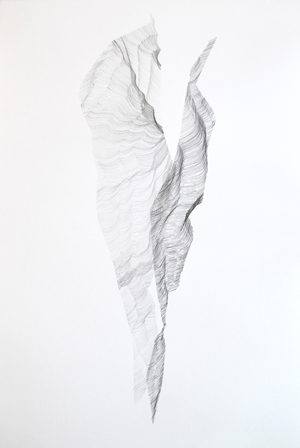 Cleave
Cleave
2012
22 by 15 in.
graphite, charcoal on paper
|
|
|
|
| |
|
|
|
|
|
|
| |
|
|
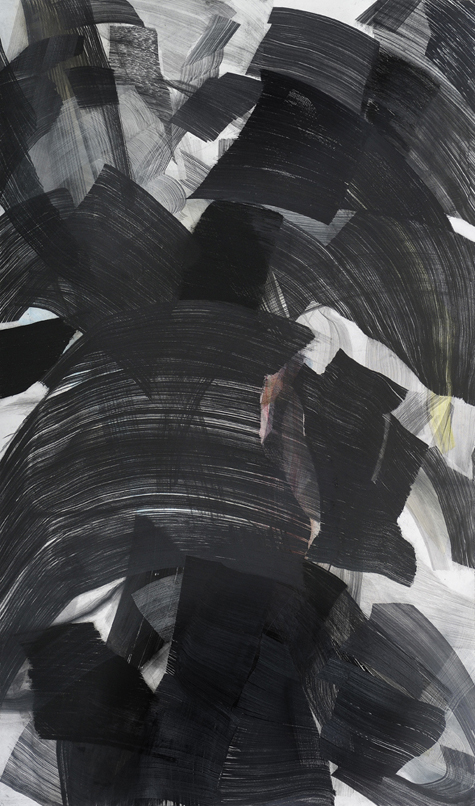 |
|
|
|
| |
|
|
(Study for) Orpheus Rebuilds
2010
90 by 50 in.
graphite, charcoal, dry pigment on paper
private collection
|
|
|
|
| |
|
|
The drawings begin with a layer of brushed charcoal and graphite. Each line is a single trace of a fracture drawn over and over, wearing the break down, reshaping the original event. They document the figure in past installations and simultaneously forecast future spaces.
Based on the 2007 installation (hereunder), this study for a large scale panorama represents a future project with an ambitious scope and scale that I am actively researching. The tension between the manipulated space of the installation, and the inclusion of both 3 and 2 dimensional drawing allows for a material complexity and spatial ambiguity that is often at the root of my practice.
|
|
|
|
| |
|
|
|
|
|
|
| |
|
|
|
|
|
|
| |
|
|
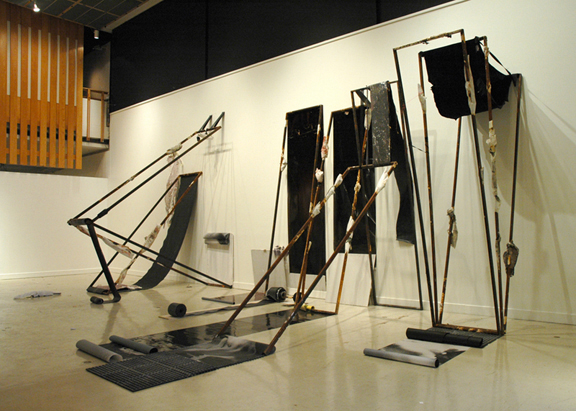 |
|
|
|
| |
|
|
Orpheus Rebuilds
(installation)
2007
mixed media: artifacts from landscape and studio
dimensions variable
The architectural planes of a space are protected with studio artifacts and then peeled around structures to provide an infrastructure for the viewer to revisit memory-images of chaos in the urban landscape.
Welded steel frames serve as the structure of this three-dimensional drawing, regular in size and shape like the prefabricated parts of urban infrastructure. These frames were used to create large scale pieces both in an outdoor public sculpture site as well as within the gallery.
As the frames were positioned, joints were secured with wood braces, like scaffolding at a construction site. Plaster molds are like bandages and scars, cracking and falling to the ground as the steel frames are moved in the act of drawing
|
|
|
|
| |
|
|
|
|
|
|
| |
|
|
|
|
|
|
| |
|
|
|
|
|
|
| |
|
|
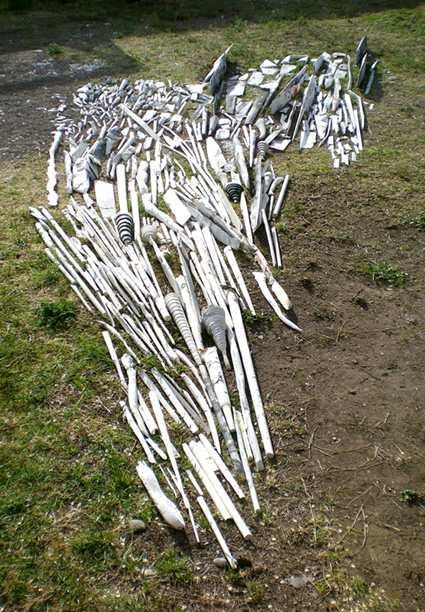 |
|
|
|
| |
|
|
Capture
2010
mixed media
dimensions variable
Capture continued a series of installations begun with drawings on drafting film made off-site, and used at various locations as casting forms for the plaster. The resultant objects were propped on the ground near a gallery with a view over the "ground drawing". Inside the gallery, specific casts were displayed on the wall in context with drawings meant to offer a documentation of the event that could have created the objects.
To make a drawing for a series of outdoor spaces, I cast plaster objects scaled to the body, from the sizes of human bones, to pieces that were the same weight or length as a body. The forms were sewn using protective plastic sheeting used in construction. I invited the public to work with me at each installation site and the final ground drawing marks an aspect of the place.
Here, the drawing sits in a gully and spent a few weeks submerged when the annual summer monsoon blasted the area with rain.
|
|
|
|
| |
|
|
|
|
|
|
| |
|
|
|
|
|
|
| |
|
|
|
|
|
|
| |
|
|
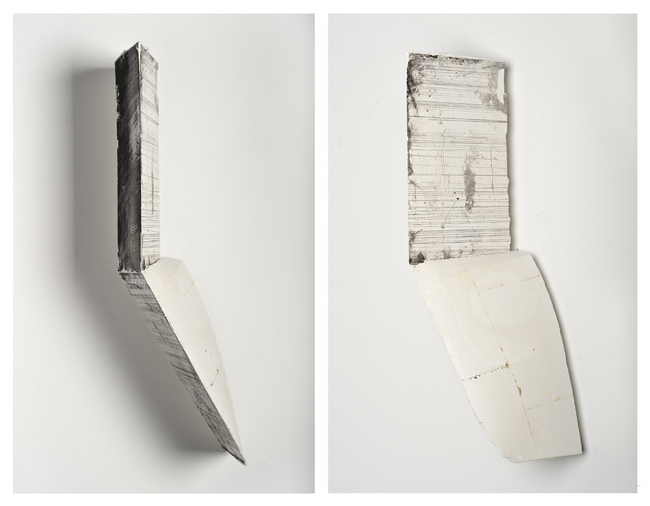 |
|
|
|
| |
|
|
Crevasse
front view (L) side view (R)
2010
20 by 10 by 6 in.
plaster, ink, gold leaf, steel
Etching plates are connected and folded into a formwork for plaster. The drawing on the plate, wiped in ink, transfers to the plaster, A line, bent, expands into a volume and calcifies at its breaking point.
Using the tools and processes of printmaking to create a very different type of art object, I connected etching plates and folded them into a formwork for plaster. The drawing on the plate, wiped in ink, transfers to the plaster. A line, bent, expands into a volume and calcifies at its breaking point.
private collection
|
|
|
|
| |
|
|
|
|
|
|
| |
|
|
|
|
|
|
| |
|
|
|
|
|
|
| |
|
|
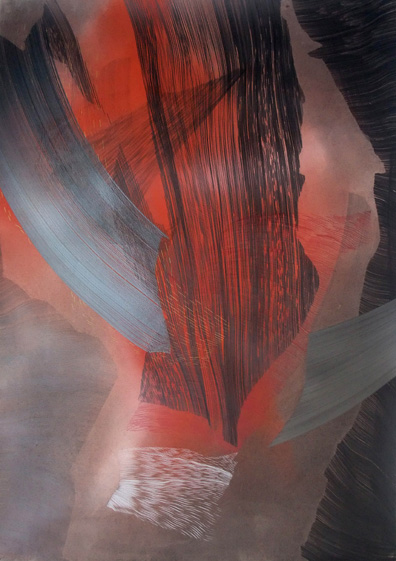 |
|
|
|
| |
|
|
Clamp
2011
iron oxide, charcoal, graphite,
and colored pencil on paper
44 by 30 in.
|
|
|
|
| |
|
|
Clamp and Lacuna (hereunder) are works that introduce a new elemental material to my studio practice. If charcoal represents a scorching, the remains of a fire, iron oxide represents the interaction of water and metal. Using materials that reference the natural world, my physical process reveals the the actions, wear and trauma that resonates on both a geological and human scale.
In Clamp, the under drawing appears to have absorbed reflections of light on a complex curve, playing with surface tension and space in a drawing that refuses to settle. |
|
|
|
| |
|
|
|
|
|
|
| |
|
|
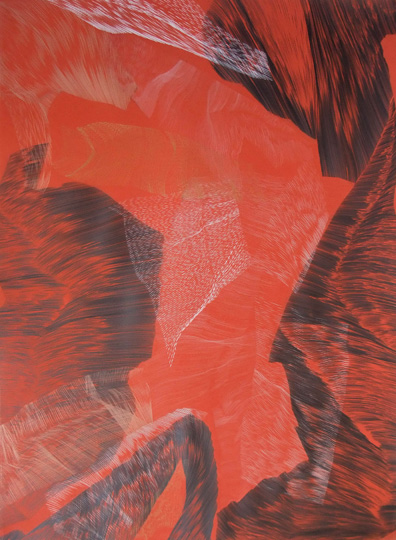 |
|
|
|
| |
|
|
Lacuna
2011
iron oxide, charcoal, graphite,
and colored pencil on paper
44 by 30 in.
private collection |
|
|
|
| |
|
|
|
|
|
|
| |
|
|
|
|
|
|
| |
|
|
|
|
|
|
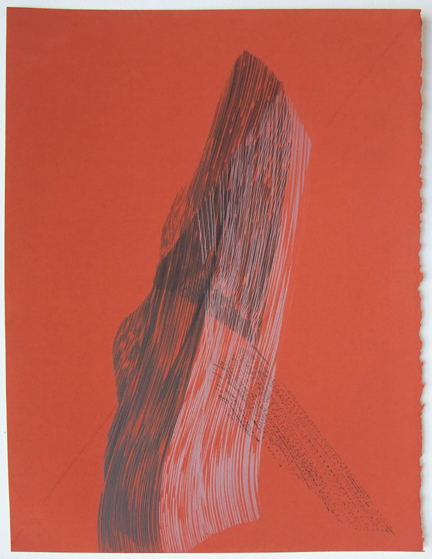 |
|
|
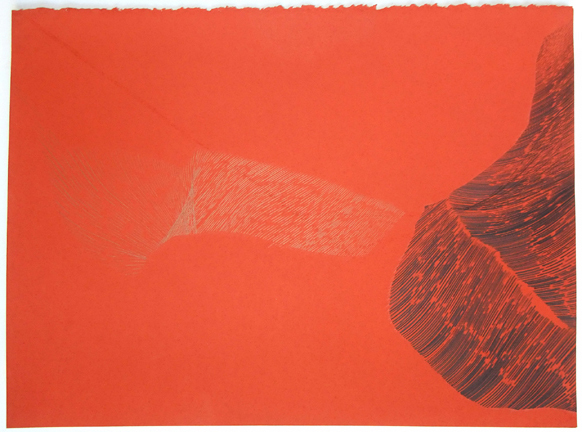 |
|
|
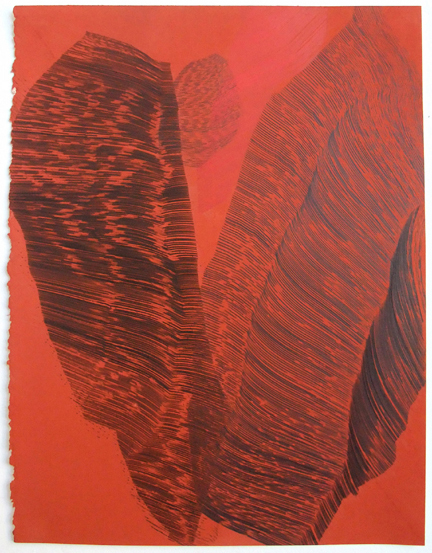 |
Leg
2011
ca. 15 by 10 in.
graphite, colored pencil on paper |
|
|
Product
2011
ca. 15 by 10 in.
graphite, colored pencil on paper |
|
|
Flex
2011
ca. 15 by 10 in.
graphite, colored pencil on paper |
| |
|
|
|
|
|
|
| |
|
|
|
|
|
|
| |
|
|
|
|
|
|
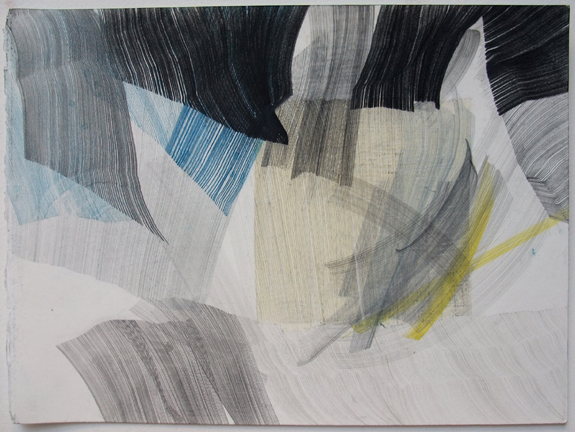 |
|
|
 |
|
|
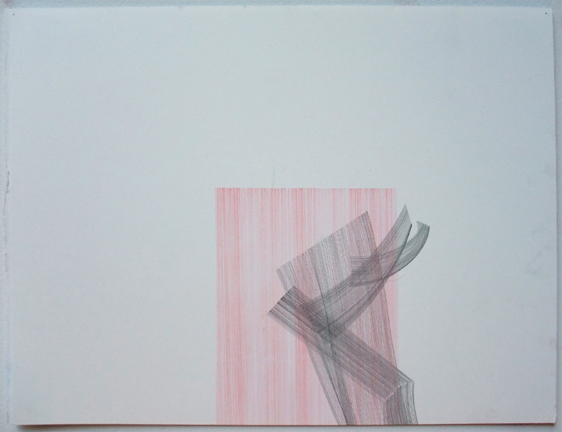 |
Monsoon
2010
ca. 10 by 15 in.
graphite, charcoal, colored pencil on paper |
|
|
Shift
2010
ca. 15 by 10 in.
graphite, charcoal, colored pencil on paper |
|
|
Red Capture
2010
ca. 10 by 15 in.
graphite, charcoal, colored pencil on paper |
private collection |
|
|
|
|
|
|
| |
|
|
|
|
|
|
| |
|
|
|
|
|
|
| |
|
|
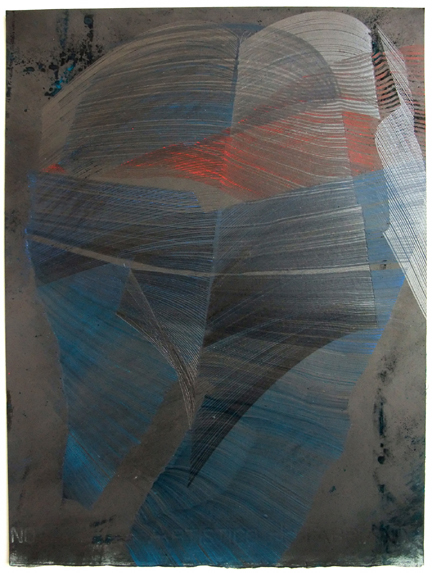 |
|
|
|
| |
|
|
Chest
2010
ca. 15 by 10 in.
graphite, charcoal, colored pencil on paper |
|
|
|
| |
|
|
|
|
|
|
| |
|
|
|
|
|
|
| |
|
|
|
|
|
|
| |
|
|
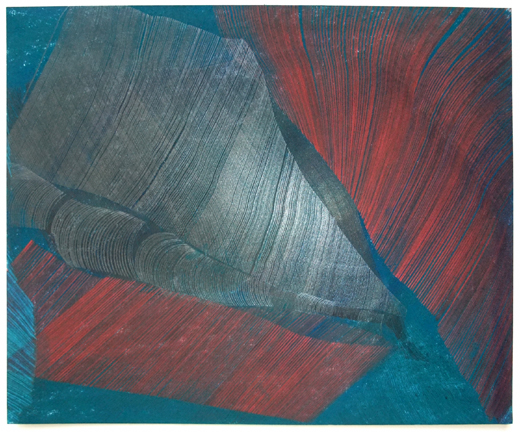 |
|
|
|
| |
|
|
Dive
2010
ca. 10 by 15 in.
graphite, charcoal, colored pencil on paper |
|
|
|
| |
|
|
|
|
|
|
| |
|
|
|
|
|
|
| |
|
|
|
|
|
|
| |
|
|
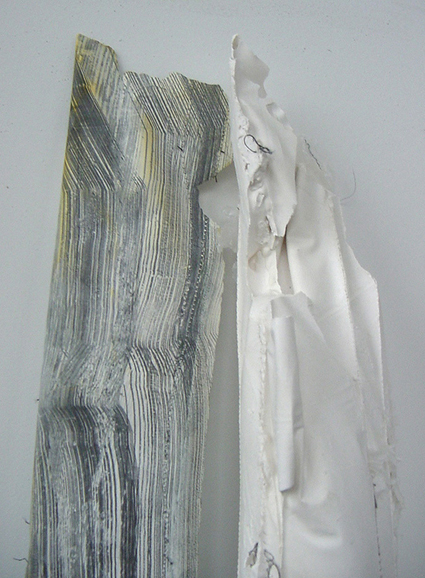 |
|
|
|
| |
|
|
Drawn, Sewn, Folded Plaster Samples
(detail)
2010
graphite, ink, dye, thread on plaster
36 by 6 by 6 in. each
Broken glass is traced onto drafting film, which is sewn or folded to make loose casting forms. Cast with Hydrocal, the drawing transfers to the plaster surface. The drawing is a map of a fracture, which now becomes part of a constructive event.
|
|
|
|
| |
|
|
|
|
|
|
| |
|
|
|
|
|
|
| |
|
|
|
|
|
|
| |
|
|
|
|
|
|
| |
|
|
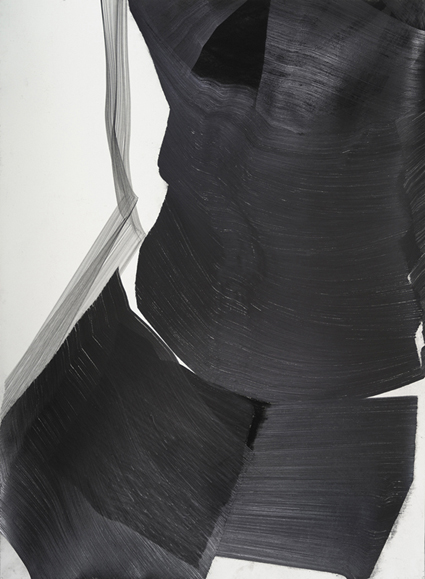 |
|
|
|
| |
|
|
|
|
|
|
| |
|
|
|
|
|
|
| |
|
|
Belly
2010
60 by 40 in.
graphite, charcoal, colored pencil on paper
private collection |
|
|
|
| |
|
|
|
|
|
|
| |
|
|
|
|
|
|
| |
|
|
|
|
|
|
| |
|
|
|
|
|
|
| |
|
|
|
|
|
|
| |
|
|
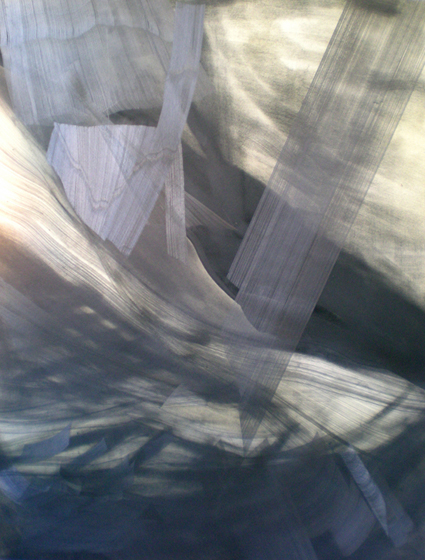 |
|
|
|
| |
|
|
Storm
2010
50 by 38 in.
graphite, charcoal, colored pencil on oiled paper
private collection |
|
|
|
| |
|
|
|
|
|
|
| |
|
|
|
|
|
|
| |
|
|
|
|
|
|
| |
|
|
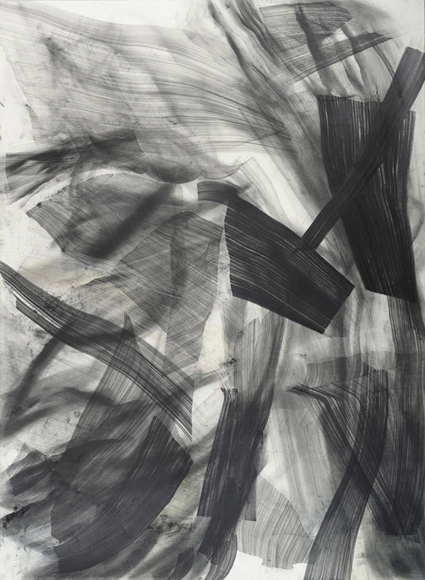 |
|
|
|
| |
|
|
East + Five Minutes
2010
60 by 44 1/8 in.
graphite, charcoal, colored pencil on paper
Brushed charcoal and colored lines speak to a vanished action implied in the drawings.
private collection
|
|
|
|
| |
|
|
|
|
|
|
| |
|
|
|
|
|
|
| |
|
|
|
|
|
|
| |
|
|
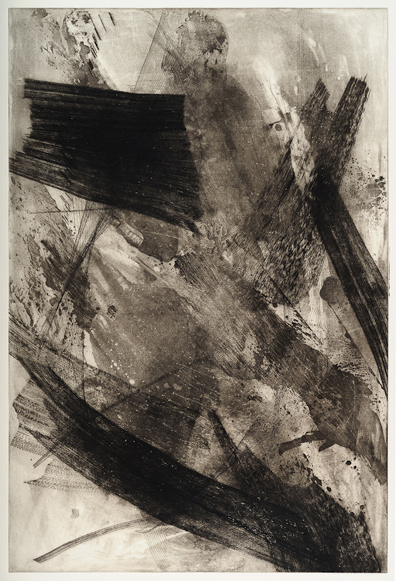 |
|
|
|
| |
|
|
Silt Wash
2010
aquatint, etching, drypoint
edition of 10
36 by 24 in. (plate)
44 by 30 in. (paper)
|
|
|
|
| |
|
|
Silt Wash and Ground Swell (hereunder) are part of a series of large copper plates prints that I am making during a residency at the Robert Blackburn Print Workshop. The process begins with spitbite aquatint: a fluid surface of ferric chloride and water that is controlled with drypoint and deeply etched lines. Burnished lines balance these actions by removing tone. I think of the prints as small scale equivalents to land moving operations--physical and demanding in their process
|
|
|
|
| |
|
|
|
|
|
|
| |
|
|
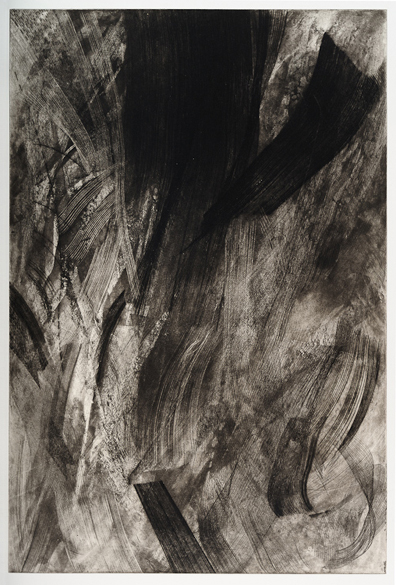 |
|
|
|
| |
|
|
Ground Swell
2010
aquatint, etching, drypoint
edition of 10
36 by 24 in. (plate)
44 by 30 in. (paper)
|
|
|
|
| |
|
|
|
|
|
|
| |
|
|
|
|
|
|
| |
|
|
|
|
|
|
| |
|
|
visit Jarrod Beck's website :
|
|
|
|
| |
|
|
 |
|
|
|